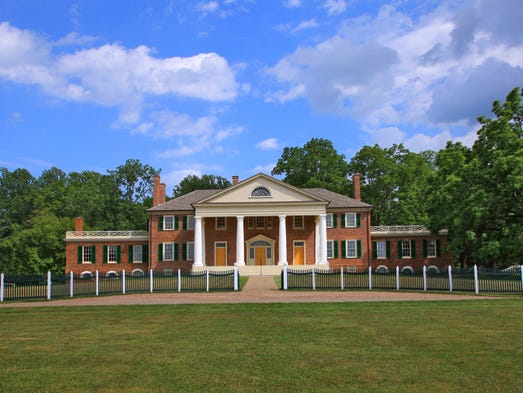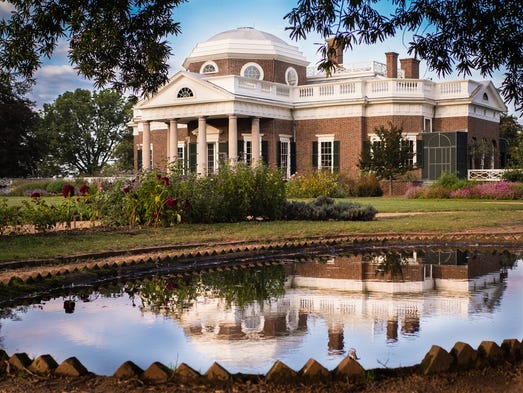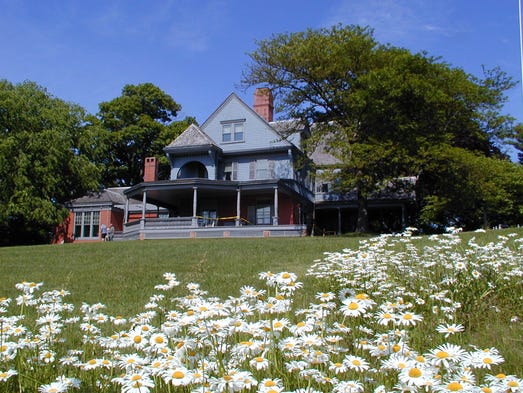Montpelier, home of James Madison
Posted!
A link has been posted to your Facebook feed.

Montpelier, home of James and Dolley Madison. The Home was restored to the 1820s retirement era of the Madisons; the South Yard slave dwellings and work buildings are being reconstructed.
Aaron Watson, The Montpelier Foundation

Montpelier, home of James Madison, fourth president of the United States, father of the Constitution and architect of the Bill of Rights. Between 2003-2008, the Home underwent a complete restoration to return it to the Madisons' retirement era of the 1820s.
Kenneth M. Wyner, The Montpelier Foundation

A view of the Blue Ridge Mountains from James Madison's upstairs library, where he spent months studying ancient and modern republics in preparation for the 1787 Philadelphia Convention.
Johnny Hugel, The Montpelier Foundation

To tell a more complete American story, Montpelier is reconstructing slave dwellings, smokehouses and a kitchen in the South Yard, as part of "The Mere Distinction of Colour" exhibition. The exhibition builds on 17 years of archaeological excavation, documentary research, oral history and cultural exploration.
Proun Design/The Montpelier Foundation

Montpelier is unique as a presidential site of the Founding Era, engaging its Descendants' Community to help guide and shape its interpretation of slavery. Here, descendants Lillie Pitchford Green and Leontyne Peck discover an oyster shell during an archaeological dig.
Eduardo Montes-Bradley, The Montpelier Foundation

Person or Property, part of "The Mere Distinction of Colour" exhibition, demonstrates the humanity of the enslaved individuals at Montpelier, bringing to light their identities as more than property.
Proun Design/The Montpelier Foundation

"E Pluribus Unum" by Rebecca Warde is a mosaic created from pieces of brick excavated at living quarters of enslaved men, women and children across Montpelier. On many plantations, bricks were made by enslaved women and children.
Proun Design/The Montpelier Foundation

A piece of a slave shackle found during a metal detecting survey at Montpelier; it is displayed in "The Mere Distinction of Colour" exhibition.
Proun Design/The Montpelier Foundation

James Madison's Montpelier. Far left: A glimpse of Mr. Madison's Temple. Center: The Home, restored to the 1820s retirement era of James and Dolley Madison. Far right: The South Yard slave dwellings and work buildings.
Jenn Glass, The Montpelier Foundation

Montpelier's 8-plus miles of well-marked walking trails are one of the Virginia Piedmont's best-kept secrets. Winding through horse pastures, wildflower meadows and forests - including the 200-acre old-growth Landmark Forest - the trails offer spectacular views of the Blue Ridge Mountains and intimate encounters with native plants and wildlife.
Ethan Hickerson, The Montpelier Foundation

Montpelier offers a number of seasonal walking tours, including the interpreter-led "We the People" trail walk on the 3.55-mile Montpelier Loop Trail. Montpelier's walking trails are free and open to the public.
Mary Furlong Minkoff, The Montpelier Foundation
Like this topic? You may also like these photo galleries:
Replay
Autoplay
Show Thumbnails
Show Captions
Montpelier was the lifelong home of James Madison, the fourth president of the United States and primary architect of the Bill of Rights. The 2,600-acre property sits in the rolling hills of the Virginia Piedmont with an unspoiled view of the Blue Ridge Mountains. At Montpelier, James Madison shaped the ideas that would become the U.S. Constitution. The National Trust for Historic Preservation, which protects and promotes Montpelier, shared these images and facts about this important presidential home.
Presidential residences: Famous homes of the commanders-in-chief
Posted!
A link has been posted to your Facebook feed.

Born at Colonial Beach, George Washington spent most of his childhood at Ferry Farm, near modern day Fredricksburg. But Washington’s most famous residence is Mount Vernon in Fairfax County, Va.
George Washington’s Mount Vernon

The Old House at Peacefield is a special home as it was the home to two American presidents, father and son John Adams and John Quincy Adams. Located in Quincy, Massachusetts, it was owned by the Adams family for four generations.
flySnow, Getty Images/iStockphoto

Thomas Jefferson’s estate, Monticello, is a popular tourist destination in Charlottesville, Va. Jefferson inherited 5,000 acres from his father in 1764 and construction first started on the Palladian-style house, which Jefferson designed, in 1769.
Thomas Jefferson Foundation at Monticello, photo by Jack Looney

James Madison’s home, Montpelier, is another early president’s estate found in Virginia. The family owned the property for years, acquired by Ambrose Madison, James’ grandfather. James and his wife Dolley, retired there after his presidency in 1817. The estate, located outside the town of Orange, was also owned by the du Pont family, before being sold to the National Trust for Historic Preservation.
Heritage Film Project, Getty Images/iStockphoto

Though not his first or last, Ash Lawn-Highland was one of James Monroe’s most prominent residences and is still available to visit today. Only referred to as “Highland” at the time, he lived there with his family for 24 years, from 1799-1824.
Neal Piper Photography

Andrew Jackson was born somewhere along the border of North and South Carolina, but is most affiliated with the state of Tennessee, where you can visit his estate, The Hermitage. He built the main brick house from 1818-1819, but much of the interior was destroyed by a fire in 1834.
Andrew Jackson’s Hermitage

Martin Van Buren was born in Kinderhook, N.Y. He later purchased an estate outside of the town, which he named Lindenwald. The grounds and 36-room mansion at Lindenwald are now maintained by the United States Park Service.
National Park Service

William Henry Harrison was born in Virginia, and his most famous house, Grouseland, in Vincennes, Ind., was designed after his family’s home in Virginia, Berkeley Estate.
William Henry Harrison's Grouseland

The James K. Polk House in Columbia, Tennessee, now a museum in the 11th president’s honor, was built by his father in 1817. At the time, Polk was attending the University of North Carolina. The primary residence of Polk and his wife, Sarah, was located in Nashville and demolished in the year 1900 by a developer to build an apartment building.
David Powers, Getty Images/iStockphoto

Though no longer in the original location and with multiple additions built on, you can visit the house that Millard Fillmore built in 1826 in Buffalo, N.Y. He only lived there for four years, though during that time, his son was born.
Aurora Historical Society

The house most associated with president Franklin Pierce is his childhood home in Hillsborough, N.H. The house was a popular meeting place for celebrities of the time, including author Nathaniel Hawthorne and politician Daniel Webster.
flickr.com/auvet

Wheatland in Lancaster, Pa., was named for the surrounding wheat fields and purchased by James Buchanan in 1848. When Buchanan was nominated as the Democratic presidential candidate in the 1856 election, instead of a tour, he ran his campaign from the property.
LancasterHistory.org

The home that Abraham Lincoln lived in when he was elected president resides in Springfield, Ill. One of the United State’s most beloved political figures, Lincoln lived in the home with his family from 1844 to 1861.
Lincoln Home National Historic Site

The Andrew Johnson National Historic Site in Greeneville, Tenn., houses several buildings: his early home, where he saw the rise of his political career; “The Homestead,” where he lived before and after his presidency; and his tailor shop, on display inside a memorial building.
Andrew Johnson National Historic Site

The farm and house which now memorialize the Commanding General of the Union Army and future president, Ulysses S. Grant, belonged to Grant’s wife’s family. Grant met Julia Dent when he was visiting the plantation as a West Point classmate of her brother.
Ulysses S. Grant NHS

The mansion called Spiegel Grove in Fremont, Ohio (now the modern Rutherford B Haye’s Presidential Center) was built by Hayes’ uncle as a summer home for the family.
Rutherford B Hayes Presidential Center bhayes.org

The James A. Garfield National Historic Park is located at a home he bought in 1876 for his growing family in Mentor, Ohio. After his assassination, Garfield’s wife created a memorial library wing for her husband.
National Park Service

Benjamin Harrison was a successful lawyer and built a beautiful 16-room home in Indianapolis, Ind., that was completed in 1875. Harrison lived in the house until he died in 1901.
David Pleiss/Benjamin Harrison Presidential Site

The only residence still in existence with ties to the 25th President, William McKinley, belonged to the family of his wife, Ida. The couple lived there during the years of 1878-1891. The house, located in Canton, Ohio, is now run by The First Ladies’ Library.
National First Ladies' Library

Sagamore Hill House in Cove Neck, N.Y., is the famous residence of Theodore Roosevelt. The president died there in 1919. Later, his eldest son, Ted, built a house on the property called Old Orchard, which you can now also visit.
National Park Service

The William Howard Taft National Historic site in Cincinnati, Ohio was the birthplace and residence of the 27th US President for almost the first three decades of his life.
NPS / William Howard Taft NHS

The Woodrow Wilson House in Washington, D.C., was the primary residence for Wilson after his presidency. He died in an upstairs bedroom in 1923. His wife, Edith, continued to live there until she died in 1961, entertaining such guests as Jacqueline Kennedy.
The President Woodrow Wilson House, a National Trust Historic Site

Warren G. Harding and his wife designed their house in Marion, Ohio. Harding, the 29th president of the United States, did much of his campaigning from the property. His press secretary lived next store and used his house as the campaign Republican Headquarters.
Harding Home Presidential Site

Though he spent most of his time living in Massachusetts, the Calvin Coolidge Homestead is located at his childhood home in Plymouth Notch, Vt. He was visiting the property when Warren G. Harding died and as the vice president at the time, took the oath of office from the front porch.
Calvin Coolidge Presidential Foundation

Herbert Hoover was born in West Branch, Iowa to a Quaker family. They lived in a small, two-room cottage, which is now on display at the Herbert Hoover National Historic Site.
National Park Service, John Eicher

Springwood Estate in Hyde Park, N.Y., is a very significant house for one of America’s most famous presidents, Franklin Delano Roosevelt. It was his birthplace, lifelong residence, and he is now buried there.
WD Urbin, Park Photographer

The Truman home in Independence, Mo., was where president Truman lived after marrying his wife in 1919. It was also the residence which they would visit from Washington, D.C. during his presidency. The Truman’s only daughter was also born in the home.
National Park Service

The Trumans also had a farm retreat in Grandview, Mo., only 15 miles from their home in Independence. It belonged to Truman’s maternal grandmother and he often worked their as a young man.
National Park Service

The home and farm of Dwight D. Eisenhower in Gettysburg, Pa., was a labor of love for the 34th president and his wife. It required almost an entire rebuild when they bought it, due to extreme dilapidation.
Eisenhower National Historic Site

The birthplace of John F. Kennedy is available to visit in Brookline, Mass. He was born in an upstairs bedroom, as were his sisters, Rosemary and Kathleen. The Kennedy’s had to relocate in 1920 to accommodate the growth of their family.
National Park Service, John Fitzgerald Kennedy National Historic Site

A common nickname for the ranch and country home in Stonewall, Texas, of Lyndon B. Johnson is the “Texas White House”. He spent much of his time in office at the estate. There is even a hangar and airstrip on the property, though it wasn't large enough to accommodate Air Force One.
NPS Photo by Cynthia Dorminey

The house in which Richard Nixon was born inYorba Linda, Calif.,was builtby his father from a catalog home building kit. Now a library and museum in the former president’s honor, the home holds many family artifacts.
Provided by the Richard Nixon Presidential Library and Museum

Ronald Reagan
Boyhood home
Dixon, Illinois
The Queen Anne-style house and boyhood home of Ronald Reaganin Dixon, Ill.,is now his NationalHistoric Site. Built in 1891, the family lived there from 1920 until 1923.
Ronald Reagan Boyhood Home
Like this topic? You may also like these photo galleries:
Replay
Autoplay
Show Thumbnails
Show Captions
Read or Share this story: https://usat.ly/2BFkOba














































Join the Nation's Conversation
To find out more about Facebook commenting please read the Conversation Guidelines and FAQs